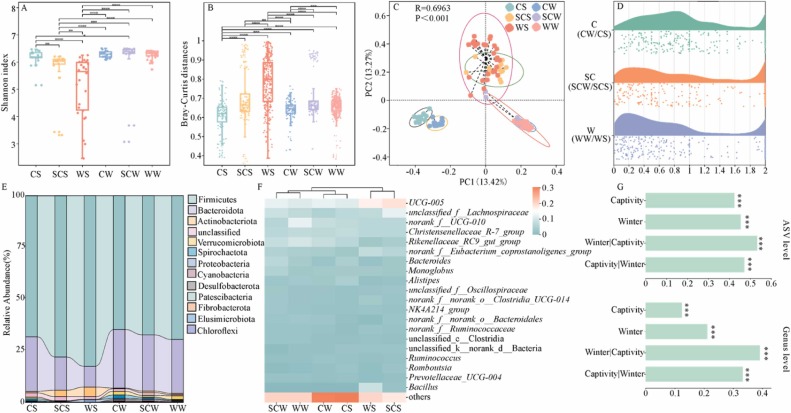Qinghai-Tibet Plateau (QTP) is marked by harsh environments that drive the evolution of unique nutrient metabolism mechanism in indigenous animal gut microbiotas. Yet, responses of these microbiotas to different extreme environments remain poorly understood. White-lipped deer (Przewalskium albirostris), a native endangered species in the QTP, serves as an ideal model to study how gut microbiotas adapt to season and human disturbances. Here, a multi-omics integrated analysis of 16S rRNA, metagenomics, and untargeted metabolomics was performed to investigate the composition, function, and metabolic characteristics of gut microbiota in White-lipped deer across different seasons and living environments. Our results revealed that extreme winter environment dominated the composition, function, and metabolism of gut microbiota in white-lipped deer. The white-lipped deer exhibited an enriched gut microbiota associated with producing short-chain fatty acids in winter, with core feature genera including norank_o_Rhodospirillales, Rikenellaceae_RC9_gut_group, and unclassified_c_Clostridia. However, potential pathogenic bacteria and few short-chain fatty acid producers, with core feature genera including norank_f_p-2534–18B5_gut_group, Cellulosilyticum, and Paeniclostridium, showed enrichment in captivity. Pathways associated with carbohydrate metabolism, amino acid metabolism, and immune regulation showed enrichment in winter group as an adaptation to the cold and food scarcity. Among these, Rikenellaceae_RC9_gut_group and unclassified_c_Clostridia contributed significantly to these metabolic pathways. The gut microbiota of white-lipped deer exhibited enrichment in pathways related to intestinal inflammation and enhanced immune regulation to alleviate the stress of captivity. Among these, norank_f_p-2534–18B5_gut_group contributed the most to these pathways. Butyric, valeric, and valproic acids were significantly more abundant in the winter group, while 3-hydroxybutyric and (S)-beta-aminoisobutyric acids were higher in the captive group. Furthermore, enriched metabolites and associated pathways in both groups further supported the inferences on metagenomic functions. This study confirms the key role of specific gut microbiota in adapting to high-altitude winters and anthropogenic disturbances, emphasizing its importance for environmental resilience in wild, high-altitude mammals.

Fig. 1. The impact of extreme winter environment and captivity on shaping the gut microbiota of white-lipped deer.
The link below will guide you to the reading:
https://doi.org/10.1016/j.micres.2025.128182
